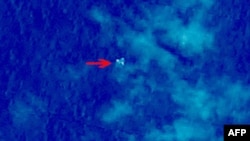Malaysia Plane: Other Unusual Incidents
Aviation Mysteries- 1937: Amelia Earhart disappears during flight over Pacific, no trace of plane found
- 1996: TWA Flight 800, en route to Paris from New York, explodes over Long Island, questions remain over cause
- 1999: EgyptAir Flight 990 crashes into Atlantic while headed to Cairo from New York; US questions if pilot comments indicated suicide mission
- 2009: Air France Flight 447 goes down over Atlantic while traveling from Rio de Janeiro to Paris, crash report indicates pilot confusion
Chinese media are describing Bejing's deployment of four naval vessels, four civilian search ships and multiple aircraft as the biggest Chinese rescue effort ever assembled. State-run television said two ships were using underwater sonar and robots to try to find the missing Boeing 777 with 239 people aboard.
Chinese helicopter teams say they are carrying out airborne searches in a methodical fashion. Yet one commander, Zhou Zun, said that spotting someone still alive in the water would be difficult.
"At a vertical height of two or three hundred meters above sea level, you see cars around the size of a match box," said Zhou. "So in case of a human being floating in the sea with only head out, the target would be tiny and really difficult for us to discern."
Satellite images a mistake
And China was forced to admit that the release of satellite images purporting to show possible debris from the Boeing 777 jet was a mistake. Malaysia said its searchers found nothing when they went looking for the supposed large-sized pieces of the aircraft.
US dispatches destroyers
The United States has dispatched two destroyers to search in the Gulf of Thailand, the Strait of Malacca and other waters between Thailand, Cambodia and Vietnam. The American military said it using Seahawk helicopters that are equipped with onboard sensors that can detect small objects in the water and infrared cameras for night-time search missions.
China, the U.S. and Malaysia are among 12 countries that have joined the search for the missing jet, a mystery that has baffled aviation experts and left them speculating as to what might have happened to Malaysia Airlines Flight 370.
Meanwhile, Cambodia has granted Vietnam permission to use its airspace as part of the search. Keo Sivorn, head of Cambodia's Civil Aviation Department, Thursday said Vietnamese aircraft have flown over Cambodian territory since Wednesday.
“Vietnam has the resources for search and rescue, and yesterday it requested cooperation from us to search for the missing plane in southern Vietnam and some parts of our flight zone." Keo said.
Earlier this week, Cambodian officials said they would not be sending resources to join the search effort, which now involves more than 80 ships and aircraft from 12 countries, including the Philippines, Vietnam, Japan, Indonesia, Singapore, Brunei, Thailand, Australia and India.
Part of this report was produced in collaboration with VOA's Khmer service.









